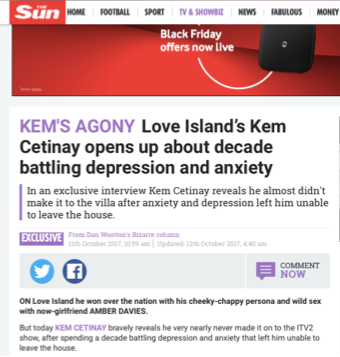From Love Island stars to global singers, why social media has contributed to health problems today
- Sid Fairbank
- Dec 12, 2017
- 3 min read
The rise of modern technology has opened many opportunities to humanity, whether this be quick access to current affairs or seeing what your favourite celebrity is doing through your smartphone. It has however caused a large division within society. Some time ago, life was always seen as ‘living for the moment’, yet recently branded as ‘pics or it didn’t happen’ by Jacob Silverman. The influence of social media has largely impacted the mental health of the youthful generation, for example, it has caused a rise in cyberbullying and depression in teens.
However, social media hasn’t just created negative effects on teens. The rise of other social media platforms including snapchat has encouraged many to speak about their mental issues. This is due to celebrities expressing their difficulties in the past with mental health.
The networking platform, created in 2010, has been swallowed by online trolls. The obsession with likes unfortunately for many has taken over the concept of Instagram. On December 6th, 2016, we saw the development of being able to turn off comments on a shared post. Why was this - maybe from the rise in figures of users getting abused. In order to tackle this, Instagram introduced a heart icon next to the comments, trying to spread positivity. This is just one example of how cyberbullying has worked. Ditch the Label – a leading international anti-bullying charity – published data showing teens facing cyberbullying from ‘online trolling’. They found that after a survey collected from 10,020 people, 42% report being bullied on Instagram, 37% on Facebook and 31% on Snapchat. What impact is this having? Is this triggering depression? For example, being bullied about the way that you look, creating insecurities.
Depression in teens has risen, with more now showing symptoms. Some of these include insomnia, loss of energy, and social isolation. Insomnia cases have risen as more are spending time on social media and staying up later at night when they could be sleeping. Social isolation can cause loneliness and social disabilities, and make an individual lack key attributes that one needs to succeed in life – e.g. job interviews/relationships. How can these have an effect on mental health? Not engaging in real conversation and stopping your body from developing as a teen are key reasons.
Social media however has put the spotlight on celebrities that have battled depression in the past. This has encouraged some to open up about their experiences and see it as a helpline. For example, snapchat saw Love Island’s Kem Cetinay open up about his battle with depression as a teenager. In a recent article published by The Sun on the explore page via Snapchat, we also saw articles similar around One Direction star Liam Payne. The online site ‘Tranqool’ have compiled a list of celebrities that have battled cases of mental health, which can be seen below, again another example of how social media sites including Twitter have focused on problems faced by society.
Therefore, we can’t solely say that social media has created a negative impact on today’s youth – it has shown celebrities, some role models, open up about their own mental health and their journey, and has encouraged others to do the same.
It is clear that social media does have a direct impact upon the young generation today. The way to battle this current situation is somewhat more complex than you may anticipate, as ‘online trolling’ will forever be evident on social media. However, mitigating the vast amounts of teens bullied is more realistic, similar to the change in Instagram in 2016. One thing is for sure however, which is that something must come into action soon, as the rate in which cases of depression and cyberbullying are growing questions the future of the younger generation.
I have compiled more research on celebrities and how they have been affected by depression, using the Steller application.









Comments